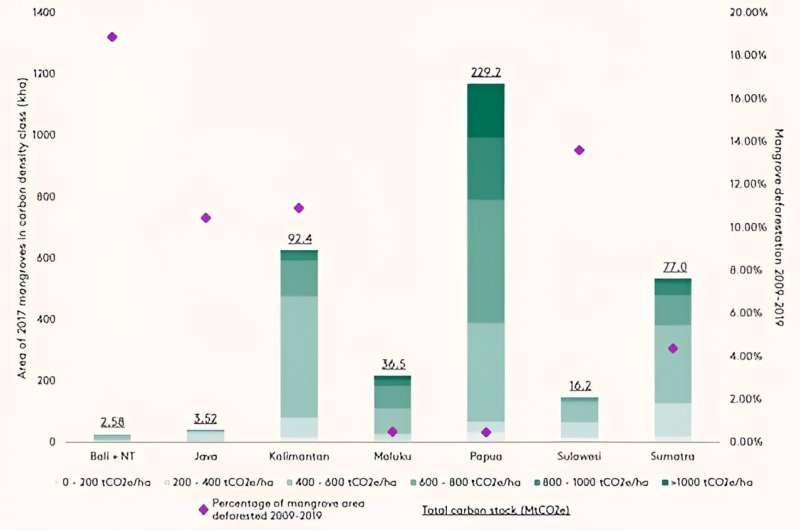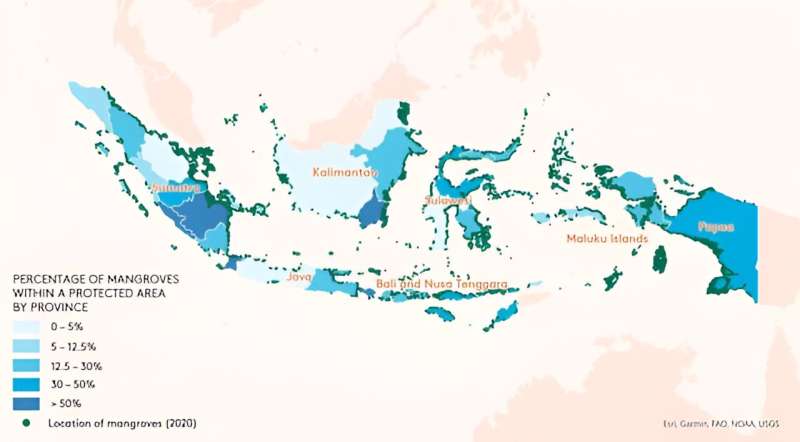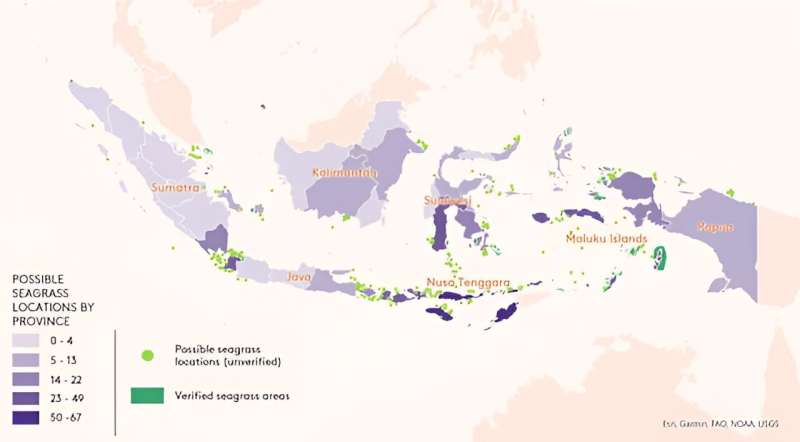This article has been reviewed according to Science X's editorial process and policies. Editors have highlighted the following attributes while ensuring the content's credibility:
fact-checked
trusted source
written by researcher(s)
proofread
Sea of opportunity: Protecting mangroves, seagrass could boost Indonesia's new climate targets

Indonesia has signaled it could include blue carbon ecosystems—carbon-rich coastal and marine areas, like mangroves and seagrass—in its new climate targets. This shift follows years of relying heavily on the forestry and land sectors as well as the energy sector.
This could be a turning point, given Indonesia is one of the most important countries globally for ocean-based climate change mitigation. Indonesia's blue carbon ecosystems are crucial, housing 22% of the world's mangroves and 5% of seagrass meadows.
However, the country is losing its mangroves and seagrass in recent years due to changes in land use. As of 2019, only 16% of mangroves and 45% of seagrass were inside protected areas. Damage to mangrove and seagrass ecosystems can release carbon into the atmosphere, exacerbating climate change.
For that reason, it's crucial that Indonesia considers establishing more protected areas for its mangrove and seagrass ecosystems as part of its new climate targets. This could shield them from harmful activities like industrial fishing, unsustainable aquaculture, massive infrastructure development and overtourism.
Two kinds of protected areas
A 2023 Climateworks Center study highlighted how Indonesia could prevent up to 60 million tons of greenhouse gas emissions per year by 2030—equal to Singapore's 2030 emissions reduction target—by protecting 39,000 hectares per year of mangroves and 8,600 hectares per year of seagrasses. The combined area of these mangroves and seagrasses is almost three-quarters the size of Jakarta.
One way to do this is by including both ecosystems inside two kinds of protected areas. The first is marine protected areas (MPAs), which are areas designated by the government to protect essential ecosystems. The other kind—known as other effective area-based conservation measures (OECM)—are just as crucial for ecosystem protection.

Many activities are prohibited in marine protected areas, such as industrial fishing, mass tourism and mining. The government plans to increase Indonesia's MPA cover from 8% to 10% by 2030, which is an opportunity to prioritize mangroves and seagrass.
Meanwhile, OECMs can allow Indonesia to target, recognize, and support areas beyond marine protected areas. These other conservation measures can play an important role in protecting blue carbon ecosystems across the country.
For example, the indigenous community of Rote Ndao in Eastern Indonesia's traditional marine management system protects the local marine ecosystems—despite not being considered a marine protected area. Research shows that Indonesia has more than 390 potential marine OECMs. Many have conservation measures that have been implemented by local communities for centuries.
Key places to protect
While Indonesia still urgently requires broad investment in the collection of high-quality data for mapping blue ecosystems, our findings highlight some key priority locations for mangroves and seagrass to be included in the country's ocean strategy.
For mangrove ecosystems, we highlight Kalimantan and Papua as areas of particular importance. Between 2009 and 2019, approximately 19% of mangroves in Kalimantan (58,000 hectares) were deforested due to palm oil and aquaculture. By comparison, Papua has a large area of carbon-dense mangroves, and a low historical rate of deforestation, with no indication of this changing.
Meanwhile, protection of seagrass is quite tricky because an Indonesian seagrass map has not been completed.

Before defining specific seagrass areas to be protected, the government can verify the data in provinces such as Maluku, North Maluku, Bangka Belitung Islands, South East Sulawesi, West Papua and South Sulawesi. These areas have the potential for seagrass ecosystems to be included in a protection plan.
The government could also prioritize seagrass ecosystems in the Riau Islands and West Nusa Tenggara. These regions have extensive seagrass areas lacking marine protected area coverage.
A new target for mangrove and seagrass protection
Indonesia can set a clear and measurable area-based target to protect its mangrove and seagrass ecosystems in the upcoming climate targets. This could align the country's climate actions on ocean and marine to its overall climate ambition. It will also lay the foundation for attracting climate financing, which Indonesia will need to achieve its targets.
Local participation is also important. Indonesia can design and implement its mangrove and seagrass ecosystems protection target with the involvement and consent of local communities. This would align with Indonesia's existing targets, such as its Blue Economy Roadmap, to ensure coordinated efforts across government agencies.
As the world works towards net zero emissions, Indonesia has a huge opportunity to boost its climate leadership. Protecting and restoring more of the country's carbon-rich mangroves and seagrass meadows can ensure the future thriving of marine ecosystems that so many Indonesians rely on.
Provided by The Conversation
This article is republished from The Conversation under a Creative Commons license. Read the original article.![]()



















